Kick-off For Chemicals in South Africa
Innovation Takes Center Circle at the 2010 World Cup
Preparation for the 2010 FIFA World Cup has involved a lot more than what gets covered in the press or on television - which has been limited to the test and qualification matches, the slow stadium construction in South Africa and the fate of David Beckham's Achilles tendon. Behind the scenes, chemical companies have been working for years leading up to now to manufacture and deliver the products that do everything from keeping the stadiums from rusting; to keeping the chairs strong; and to making the ball roll smoothly over the field.
Tough Grass for Tough Games
The blades of grass on the fields in the Mbombela Stadium in Nelspruit and the Peter Mokaba Stadium in Polokwane are a World Cup first: The roots of the grass have been integrated into 20 million artificial turf fibers, which are buried 20 cm under the field. According to Belgium's Desso Sports Systems, developer of the Desso GrassMaster system, the roots of the natural grass intertwine with the artificial fiber, which anchors the field into a stable and a level grass surface. This reinforcement of the natural grass makes the field durable in all types of weather and keeps the field in good shape after intense usage.
Most people, however, won't get to experience the feel of the grass on the World Cup stadiums' fields themselves. That doesn't mean that the normal fan attending a game won't get to enjoy the benefits of first-class chemical innovations, from the seats to the walls of the stadiums.
Edge-of-your-Seat
While soccer fans hope that there won't be much reason for sitting during the games, the seats in the stadiums will at least offer a place to take a breather and enjoy a beer during half time. Lanxess and Blue Cube have been working together on the stadium seating for the Soccer City Stadium, called Integra. Lanxess provided its Durethan, a tailor-made polyamide 6 material for metal replacement solutions in outdoor applications, for the high-tech stands, tip-up mechanism and arm rests of the chairs. Durethan keeps the seats strong - (because who can sit still at a soccer game?) and corrosion resistant. An added benefit - thanks to the smooth design, the stands are easy to clean, minimizing a fan's chances of accidently sitting in chewing gum.
The Calabash
The unique shape of the Soccer City Stadium was fashioned after an African pot design called the calabash. South African Boogertman Urban Edge + Partners, the architecture company who designed the stadium, said that the calabash represents the melting pot of African cultures. The sand-colored membrane is made of polytetrafluoroethylene (PTFE) membrane and covers about 43,000 m2 in coatings. Over 100,000 steel parts were manufactured for the lining of the stadium and came from Germany.
Sabic Innovative Plastics provided their Lexan Thermoclear Sheet for the glazing and cladding of the Soccer City Stadium in Johannesburg. Aside from providing energy savings through its insulation properties, the Lexan Thermoclear also offers ultraviolet protection.
Celebrating Flight
Jabulani, which means "to celebrate" in Bantu, is the name of the official soccer ball for the World Cup. Developed by Adidas, this high-tech polyurethane ball is made with only eight thermally welded panels that have been molded spherically to retain shape and create a seamless sphere. Adidas said that goalies will be happy with the "grip-n-groove" texturing, which is also to aid smooth flight, similar to golf balls. Adidas worked closely together with Bayer and BASF in developing the Jabulani,
Elite Feet
Nike's brand-new Elite series has been designed with super-strong, lightweight carbon fiber plates, reducing the weight players have to carry around with them on the field. Nike's design team, along with its Nike Sports Research Lab, spent nearly four years with game analysis, biomechanical studies and player testing in order to gain a new understanding of how to deliver the new innovations.
Chemical Industry in South Africa
Generally speaking, the World Cup has also given a boost to South Africa's chemical industry. According to Frost & Sullivan, the South African chemicals industry was able to remain robust in 2009 despite the worldwide economic turndown. So far, a total of €1.2 billion (R11.92 billion) has been spent towards stadium construction alone - a boon for suppliers of construction chemicals.





